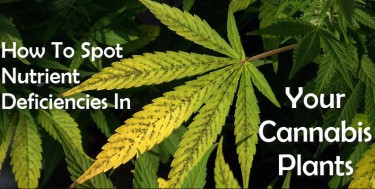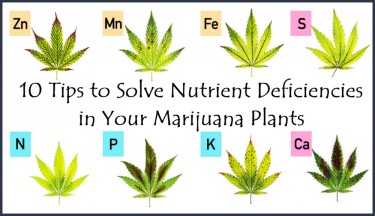
How to Explain Your Cannabis Plant’s Nutrient Deficiencies and Excesses
I saw this awesome cannabis graphic on Twitter posted by Cannabis Hub HQ which illustrated different plant symptoms to help growers identify whether they have a nutrient deficiency or are overfeeding their plants. While the picture is awesome and covers a lot of information, the major problem with it is that it’s very small. Most people will be unable to read it without zooming in, and thus to compliment this fantastic work by “Jorge Cervantes” and “LoudClouds” – the original people who made it, I’ve decided to write out each block for your convenience.
Now, if you identify something, you can look it up right here on Cannabis.net.
Let’s get started since there’s a lot to cover.
Primary Nutrients
NITROGEN:
Deficiency:
-
Lower leaves turn yellow
-
Leaves loose luster
-
Yellowing progresses upward
-
Leaves continue to yellow, curl and discolor.
-
Leaves start to drop
-
Plants are shorter with smaller leaves
-
Premature Flowering and Low Yield
Excess:
-
Bottom leaves turn lush dark green
-
Greenness moves up
-
Foliage becomes weak
-
Stems become weak
-
Water/fluid transport system becomes weak
-
Harvest tastes green
PHOSPHOROUS
Deficiency:
-
Leaves turn bluish green
-
Petioles turn purple color
-
Vertical and Lateral Growth Slows
-
Dark copper-colored or purple-to-blackish dead blotches on lower leaves
-
Severely affected leaves develop dark bronzish metallic purple colored leaves continue to curl, contort, wither and drop
-
Weak plants susceptible to diseases and pests
Excess:
-
Zinc and iron micronutrient deficiencies
-
Newer leaves develop interveinal chlorosis
-
New Leaves grow thin blades
-
Leaf tips and margins burn
-
Less intermodal space
-
Diminished harvest
-
-
Calcium and Magnesium Deficiencies appear
-
Lower leaves curl, develop spots
-
Root tips the black
-
-
Dry buds have a chemical taste
POTASSIUM:
Deficiency:
-
Older leaves turn pale and suffer chlorosis
-
Leaf margins, tips turn rusty color and burn
-
Stems often become weak, scrawny and sometimes brittle
-
Stem branching may increase
-
Flowering retarded and diminished
Excess:
-
Root zone is acidified
-
Causes calcium, magnesium, zinc and iron deficiencies
-
Newer leaves develop interveinal chlorosis
-
New leaves grow thin blades
-
Leaf tips and margins burn
-
Less intermodal space
-
Lower leaves curl develop spots
-
Root tips the black.
-
SECONDARY NUTRIENTS
CALCIUM
Deficiency:
-
Lower leaves contort and curl
-
Yellowish-brown irregular spots develop on leaves and margins
-
Flower development is slow
-
Root tips may die black
-
Stunted plant, diminished harvest
Excess:
-
Minor leaf wilt
-
Growth may be stunted
-
Uptake of potassium, iron, magnesium and manganese blocked.
magnesium
Deficiency:
-
Deficiencies exist 4-6 weeks before outward signs are apparent.
-
Interveinal yellowing and irregular rust-brown spots appear on older and middle-aged leaves
-
Overall sickly appearance
-
Older leaves dry, often curl and drop.
Excess:
-
Stunted Growth
-
Dark green foliage
-
Symptoms appear as an overall salt toxicity
SULFUR
Deficiency:
-
Young leaves turn lime-green to yellowish and growth is stunted
-
As shortage progresses, leaf veins yellow and lack succulence
-
Leaf tips can burn, darken, and hook downward
-
Long purple streaks might appear the length of the stem when combined with an overall nutrient deficiency
-
Steps often turn woody
-
Bud formation is slow and weak
Excess:
-
Overall smaller plant development and uniformly smaller, dark-green foliage.
-
Leaf tips and margins could discolor and burn when excess is severe.
BORON:
Deficiency:
-
Stem, tip, and roots grow abnormally
-
Growth shoot appear burned and may contort
-
Necrotic spots develop between leaf veins
-
Leaves thicken and become brittle
-
Rust colored corky stems develop
-
Root tips often swell, discolor and stop elongating
Excess:
-
Leaf tips yellow before appearing burned
-
Leaves yellow and drop
manganese
Deficiency:
-
Young leaves show interveinal chlorosis symptoms first
-
Necrotic (dead) spots develop on severely affected leaves, which become pale and fall off.
-
Telltale sign of manganese deficiency is where margins remain dark green around interveinal chlorosis
-
Symptoms spread from younger to older leaves as the deficiency progresses
Excess:
-
Young and newer growth develops chlorotic, dark orange to dark rusty-brown mottling on the leaves
-
Tissue damage shows on young leaves before progressing to older leaves
ZINC
Deficiency:
-
New and young leaves exhibit interveinal chlorosis, develop small, thin blades that contort and wrinkle.
-
Often stem tips fail to elongate and growing shoots/tips become bunched up.
-
The leaf tips and later the margins discolor and burn
-
Reduces intermodal spacing, stunts new growth, including buds, and can severely diminish yield.
TRACE ELEMENTS
CHLORINE
Deficiency:
-
Leaf tips and margins burn, turn bronze color
-
Young foliage turns pale green and wilts
-
Roots develop thick tips and become stunted
EXCESS:
-
Yellowish-bronze leaves are smaller and slower to develop.
-
Young leaves develop burned tips and margins
NOTE: Both severe deficiency and excess of chlorine have the same symptoms: bronze-colored leaves.
MOLYBDENUM
Deficiency:
-
In cold weather, older and middle leaves yellow with possible interveinal chlorosis
-
Leaves become distorted, margins dry
-
Leaves drop
Excess:
-
Causes a deficiency of iron
-
Leaves discolor
COPPER:
Deficiency:
-
Young leaves and shoots wilt, contort and may die black
-
Leaf tips and margins turn dark green to copper gray and die black
-
Growth is slow and yield decreases
Excess:
-
Slower overall growth
-
Interveinal iron chlorosis
-
Fewer branches grow
-
Roots start to decay, or become thick and slow growing.
IRON:
Deficiency:
-
Young leaves and shoots develop interveinal chlorosis starting at the opposite end of the leaf tip.
-
As deficiency progresses more and larger leaves demonstrate interveinal chlorosis
-
Leaves may develop necrosis and drop
-
Growth is slowed and harvest diminished.
Excess:
-
Leaves turn bronze, with small dark-brown leaf spots
-
Phosphorous uptake is impaired, signs appear in lower leaves.
MOBIE & REAL ESTATE NUTRIENTS
Deficiency:
-
Immobile nutrients show nutrient deficiency and excess on newer leaves
-
Mobile nutrient shows nutrient deficiencies & excess on older leaves
-
Toxic salt buildup locks out nutrients causing deficiencies & excess
-
Overwatering is common. Causes nutrient deficiencies & excesses. Drowns and rots roots.
AVOID NUTRIENT PROBLEMS WITH:
-
Air circulation
-
Air ventilation
-
air temperature
-
Air humidity
-
Adequate light
-
Clean water
-
Organic Soil
-
Regular maintenance
**Irrigation runoff is essential for healthy growth.
FINISH UP
There you have it, the long and painstaking task of extracting the text to take this graphic to the next level. Now you can have the graphic as a main means of identifying issues, and consult this blog for the breakdown of each.
MORE ON CANNABI PLANT NUTRIENTS, READ THESE…

HOW TO SPOT CANNABIS PLANT NUTRIENT ISSUES FAST, READ THIS!
OR..

10 TIPS FOR FIXING NUTRIENT ISSUES IN MARIJUANA PLANTS FAST.

Post a comment: